
SS John W. Brown is a Liberty ship, one of two still operational and one of three preserved as museum ships. As a Liberty ship, she operated as a merchant ship of the United States Merchant Marine during World War II and later was a vocational high school training ship in New York City for many years. Now preserved, she is a museum ship and cruise ship berthed at Pier 13 in Baltimore Harbor in Maryland.

The first USS Warrington (DD-30) was a modified Paulding-class destroyer in the United States Navy during World War I. She was named for Lewis Warrington.

USS McDougal was an O'Brien-class destroyer built for the United States Navy prior to the American entry into World War I. The ship was the second U.S. Navy vessel named in honor of David Stockton McDougal, a U.S. Navy officer notable for his leadership during an 1863 battle off Japan while in command of Wyoming.
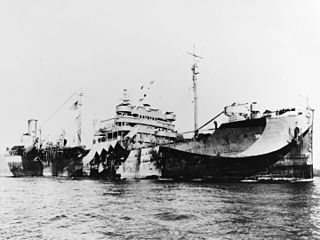
The second USS Winooski (AO-38) was a Kennebec-class oiler in the United States Navy.
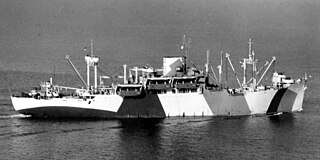
USS Thomas Jefferson (APA-30), serving from 1 May 1942 until 18 July 1955, was a transport and then reclassified on 1 February 1943 as a President Jackson-class attack transport. She was laid down under Maritime Commission contract as President Garfield on 5 February 1940 at Newport News, Virginia, by the Newport News Shipbuilding & Drydock Company for the American President Lines. The ship was launched on 20 November 1940, sponsored by Miss Eugenia Merrill. President Garfield was completed 26 March 1941 and acquired by the War Shipping Administration (WSA) 29 November 1941 with American President Lines, the WSA agent, operating the ship as a troop transport. On 1 May 1942 the United States Navy purchased the ship and commissioned her USS Thomas Jefferson on 31 August 1942.
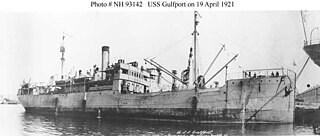
USS Gulfport (AK-5) was a cargo ship acquired by the U.S. Navy for service in World War I.
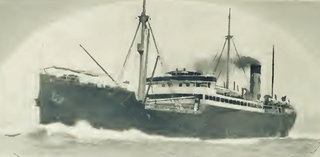
USS Wilhelmina (ID-2168) was a transport for the United States Navy during World War I. Built in 1909 for Matson Navigation Company as SS Wilhelmina, she sailed from the West Coast of the United States to Hawaii until 1917. After her war service, she was returned to Matson and resumed Pacific Ocean service. In the late 1930s she was laid up in San Francisco, California, until sold to a British shipping company in 1940. While a part of a convoy sailing from Halifax, Nova Scotia, to Liverpool, she was sunk by U-94 on 2 December 1940.

USS Lenape (ID-2700) was a troop transport for the United States Navy in 1918, during World War I. She was launched in 1912 as SS Lenape, a passenger steamer for the Clyde Line. After the entry of the United States into World War I in 1917, she was chartered by the United States Army as transport USAT Lenape. After her Navy service ended in October 1918, she was returned to the Army.

USS Rijndam (ID-2505) was a transport for the United States Navy during World War I. Both before and after her Navy service she was known as SS Rijndam or Ryndam as an ocean liner for the Holland America Line.

USS Bali was a large Dutch freighter seized in New York City by the U.S. Customs Service during World War I. She was assigned to the U.S. Navy and later the U.S. Army as a cargo ship to be used to carry military cargo to Allied forces in France. After a number of transatlantic voyages, she was returned to the Dutch government at war's end. She subsequently remained busy transporting cargo until World War II, when she was wrecked by Luftwaffe bombers in the Mediterranean. Her remains were reclaimed and disposed of by scrapping in 1951.

SS El Occidente was a cargo ship for the Morgan Line, a subsidiary of the Southern Pacific Company. During World War I, she was known as USAT El Occidente in service with the United States Army and as USS El Occidente (ID-3307) in service with the United States Navy. At the end of war, she reverted to her original name of SS El Occidente.

USS Zuiderdijk was a cargo ship that served in the United States Navy from 1918 to 1919.

The second USS Wachusett (ID-1840) was a cargo ship that served in the United States Navy from 1918 to 1919.
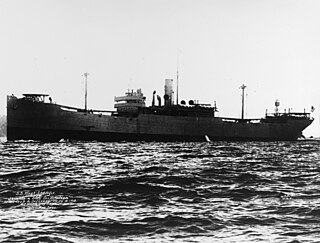
USS West Lianga (ID-2758) was a cargo ship for the United States Navy during World War I. She was later known as SS Helen Whittier and SS Kalani in civilian service under American registry, as SS Empire Cheetah under British registry, and as SS Hobbema under Dutch registry.
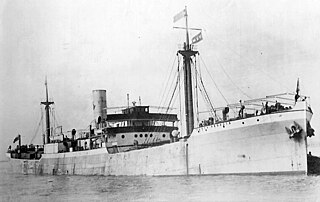
USS Santa Rosalia (ID-1503) was a United States Navy cargo ship in commission from 1918 to 1919.

USS Walter D. Munson (ID-1510) was a United States Navy cargo ship in commission from 1918 to 1919.

USS Stephen R. Jones (ID-4526) was a cargo ship that served in the United States Navy from 1918 to 1919.
SS Empire Chamois was a 5,864 GRT cargo ship which was built in 1918 by Ames Shipbuilding and Drydock Co, Seattle. She was ordered by the Compagnie Générale Transatlantique but was requisitioned by the United States Navy and commissioned as USS West Mount with the pennant number ID-3202 in 1918. She was decommissioned in May 1919 and passed to the United States Shipping Board (USSB) as SS Westmount. In 1927 she was sold to the Dimon Steamship Corporation and renamed SS Pacific Redwood. She returned to the USSB in 1932 and passed to the United States Maritime Commission (USMC) in 1937. In 1940, she was passed to the Ministry of Shipping, passing to the Ministry of War Transport in 1941 and being renamed SS Empire Chamois. She was sold to Astral Shipping Co Ltd in 1946 and renamed SS Granview. In 1949 she was sold to the Compagnia Maritime del Este, Panama and renamed SS Chamois, serving until 1958 when she was scrapped. She was the last Ames-built ship afloat.

USS Western Chief (ID-3161) was a cargo ship of the United States Navy that served during World War I and its immediate aftermath. As SS Western Chief, she was sunk during World War II after being sold to the United Kingdom for use as a merchant ship.

USS Saetia (ID-2317) was a United States Navy cargo ship in commission in 1918 that was sunk during World War I.


















